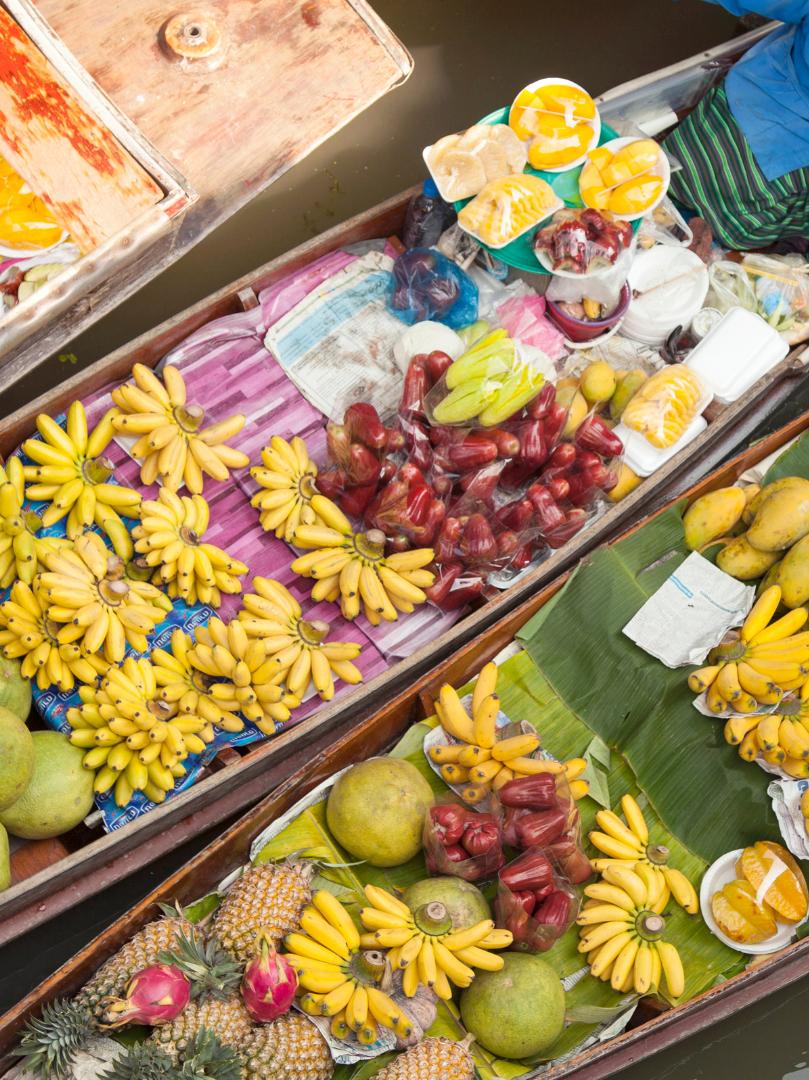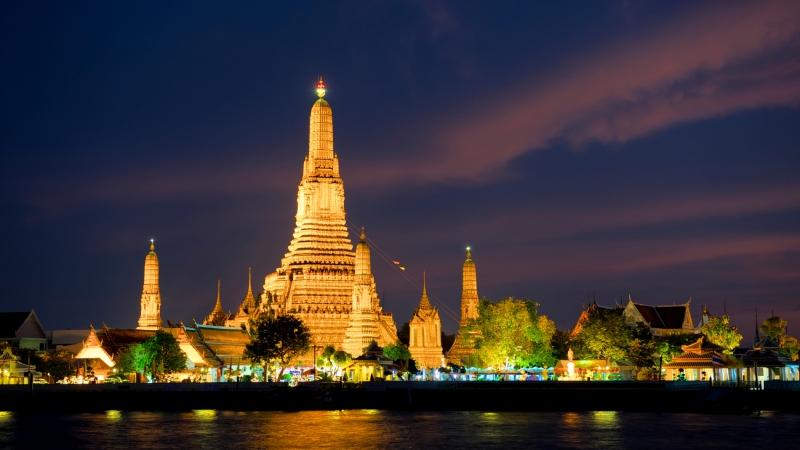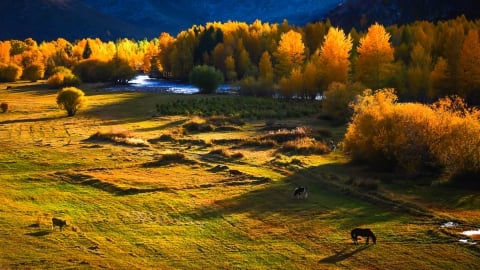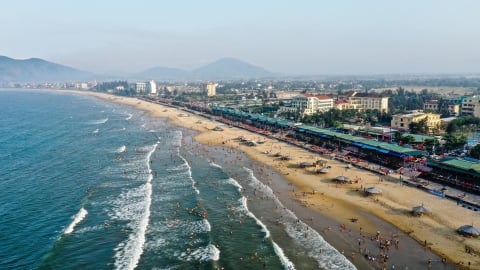Thailand is a diverse destination that appeals to everyone. Blessed with a wide range of exciting sand-based activities, the 513 square kilometer country also boasts pristine forests, picturesque mountains, bustling yet crowded markets and cities with their own unique culture and history.
BANGKOK - CITY FAMOUS FOR ITS RICH CUISINE AND VIBRANT NIGHT CULTURE
Many visitors to Thailand often see Bangkok as a transit point to other destinations, overlooking the “quiet charm” of the city itself. However, Bangkok is actually an ideal destination to stay for at least a few days before exploring other parts of Thailand.
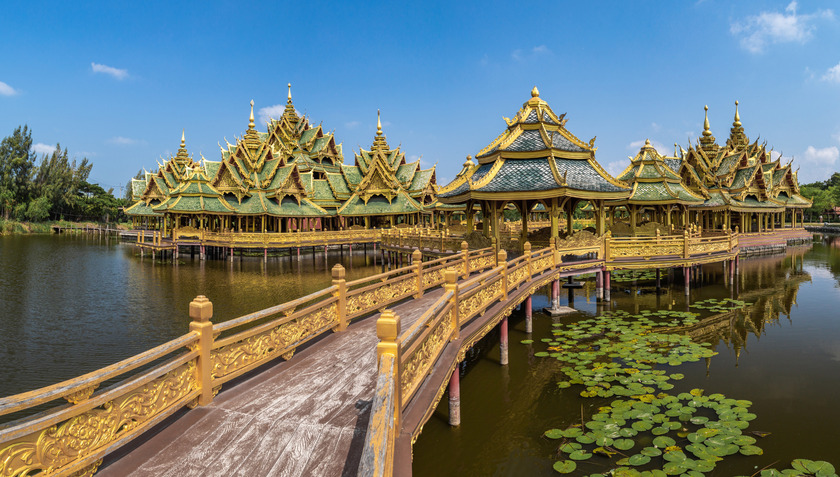
Bangkok is one of the most famous tourist destinations in Thailand, attracting a large number of visitors.
Bangkok is the capital city with the longest name in the world with 168 characters and has been recognized by the Guinness Book of Records as the longest capital city name in the world and is in the top 5 longest capital names in the world.
In Vietnamese it means “City of angels, great city of immortals, magnificent city of nine gems, seat of the king, city of royal palaces, homeland of the gods, erected by Vishvakarman at the command of Indra”.
With more than 10 million people, Bangkok is a large metropolis. It preserves many of Thailand's long-standing cultural and historical values. Tourists can visit famous places such as the Grand Palace, Temple of the Emerald Buddha, Temple of Dawn, Wat Pho, etc. to admire the unique architecture and learn about traditional Thai culture. Due to the influence of Buddhism, the city is also home to many famous temples because of the beauty of the gilded statues, which add to the sacredness.
“Venice of the East” with the Chao Praya River winding along the modern buildings and below that people still walk on the river as an ancient feature. With the development of Bangkok now but always keeps the beauty that is rare in any country.
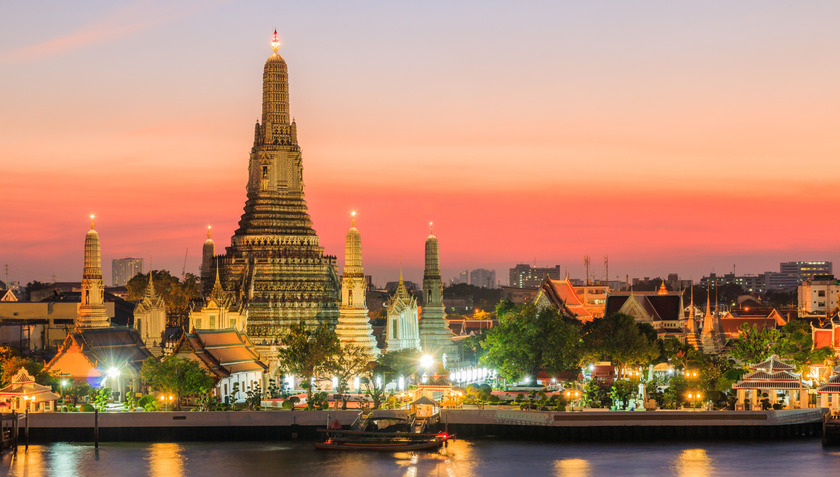
Bangkok tourism is like a piece of music with a full range of emotions, from bustling streets, vibrant entertainment areas to ancient, quiet palaces and temples.
Bangkok is known as the Venice of the East with the Chao Praya River winding through the modern buildings and below it people still walk on the river as an ancient feature. With the development of Bangkok now but still always retains the beauty that is rare in any country.
Coming to Bangkok, you can not only admire the natural beauty, culture and people here, but also experience the cuisine with the unique flavors of this splendid capital. Thai dishes are a delicate combination of many different ingredients and herbs, spices and fresh foods with special cooking styles to bring out the unique flavors of the Thai people. More than 320,000 restaurants in the city serve dishes from Thailand, Ethiopia to Latvia, and more than 500,000 street food vendors ensure that food is available anywhere in Bangkok 24 hours a day.

Many tourists compare Bangkok to a "feast" of the senses.
CHIANG MAI - HISTORIANS' PARADISE
Chiang Mai is a great base for exploring the surrounding mountains, caves and waterfalls, all of which can take at least three days of your trip. As the former capital of the Northern Lanna empire, the Chiang Mai area also boasts more than 300 temples. Some, like Doi Suthep, are famous for their stunning views; others, like Wat Suan Dok, are the burial place of the ashes of former Chiang Mai royalty. The charming, weathered Wat Chedi Luang, founded in 1385, is conveniently located in the heart of the Old City, while Wat Phra Singh, home to the Lion Buddha, dazzles in the sunshine with its golden stupas.
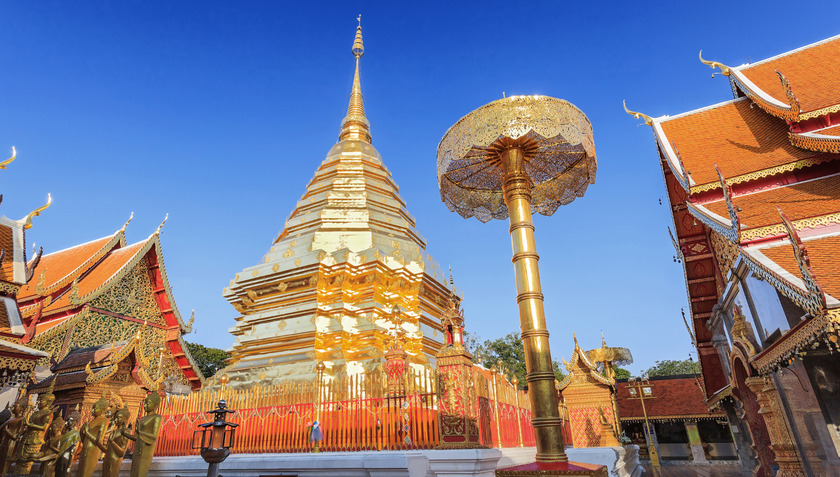
Chiang Mai was once the capital of the Lanna Kingdom (1296 - 1768), so there are still many temple relics, old buildings, or ruins here.
Chiang Mai is a great place to explore the surrounding mountains, caves and waterfalls. The former capital of the Northern Lanna empire, the Chiang Mai region boasts a rich tapestry of culture and architecture. Known as the ‘new city’, Chiang Mai defies its name with its abundance of ancient architecture and over 300 Buddhist temples, making it a historian’s paradise. This city rich in Lanna heritage is a vibrant blend of past and present, where traditional Thai houses whisper tales of a bygone era. Visitors are invited to immerse themselves in the city’s cultural landmarks, each reflecting the artistic and spiritual heritage of the Lanna kingdom.
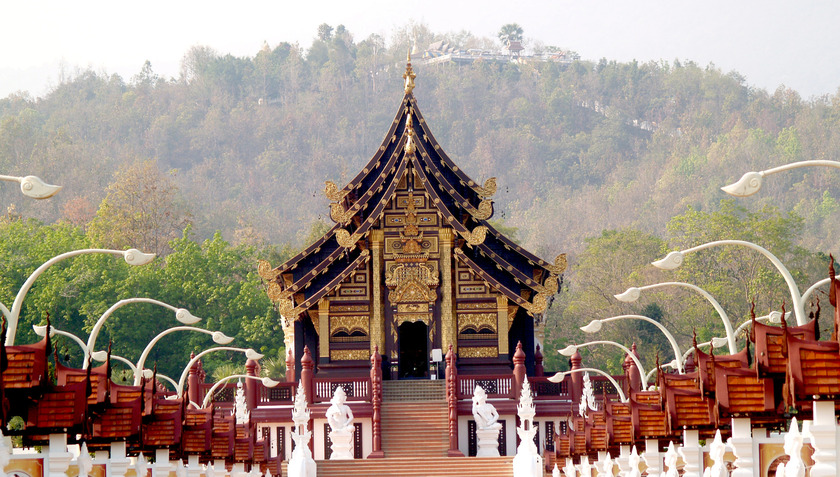
Although it has a quiet, wild atmosphere, it is not as peaceful as many other places. Chiang Mai has a mysterious and enchanting look.
Walking through the streets of Chiang Mai, one cannot help but be captivated by the unique Lanna architectural style. From the intricate wood carvings to the steep roofs of traditional Thai buildings, the city is a living museum showcasing centuries of history and design. For architecture enthusiasts and casual travelers alike, Chiang Mai offers a rare opportunity to explore the architectural evolution of Northern Thailand, from ancient wooden houses to grand temples.
Bhubing Palace: A Royal Blend of Culture and Nature
Bhubing Palace, built in 1961, is a spectacular piece of northern Thai architecture known as the 'Reun Mu' (Group of Houses). This royal residence features stunning pillars and is surrounded by the natural beauty of the Chiang Mai hills. The serenity of Bhubing Palace with its rose gardens and stunning views offers a tranquil retreat from the hustle and bustle of the city.
The charm of Tha Pae Gate
Tha Pae Gate, a remnant of Chiang Mai’s ancient city wall, is a testament to the city’s rich history. Once a fortress of the “Old City”, the gate now serves as a gateway for explorers to delve into Chiang Mai’s cultural heart. As a tourist hub, Tha Pae Gate is not only an architectural marvel but also a bustling hub where the past meets the present.
CHIANG RAI "GOLDEN TRIANGLE" - A GLANCE OF THE EXTREME NORTH OF THAILAND
Known as the Golden Triangle, Thailand’s northernmost region – where Thailand, Laos and Myanmar meet – has been a destination for die-hard nature lovers for decades. Once a major opium producer, the Golden Triangle is now a place where tourists can cruise along the Mekong River for breathtaking views and camp in mild weather. Not too remote, but like stepping into a notorious past that terrified the world, these are the things that will captivate you when you come here.

Chiang Rai province is located in the far north of Thailand, with the capital city being Chiang Rai, about 200km from Chiang Mai, slightly to the northeast.
A glimpse of Chiang Rai city
The first destination is the White Temple - Wat Rong Khun - a famous temple in the southern suburbs of Chiang Rai city, about 20km from the center, right next to Highway 1 - Phaholyothin Avenue. The temple was newly built in the early 21st century, but is very famous for tourists to Chiang Rai because of its intricate and sophisticated decoration, and especially the entire temple is painted in pure white.
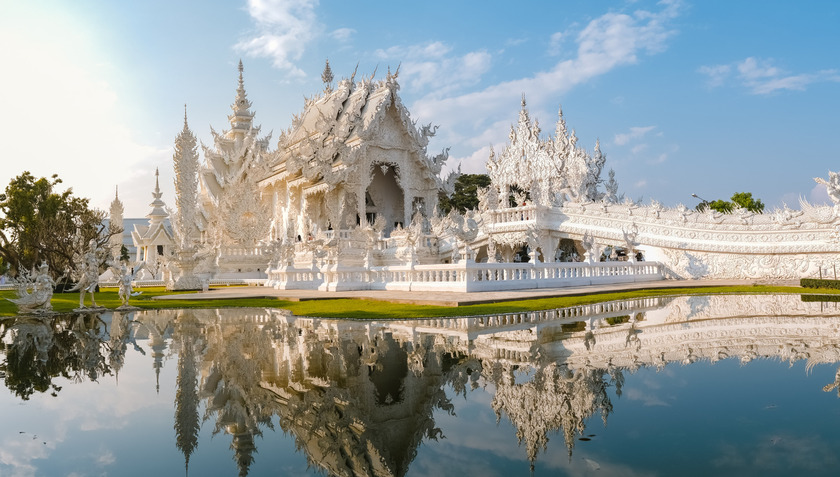
This province has a quite famous area: Golden Triangle, the border junction between Thailand - Laos - Myanmar.
Visit the "heart" of the Golden Triangle - Sop Ruak
Sop Ruak village lies in the heart of the Golden Triangle, the natural border between Myanmar, Thailand and Laos. In the past, Sop Ruak was an integral part of the drug trade and you can learn about this illicit history at the Opium House and Opium Museum in the Golden Triangle Park.
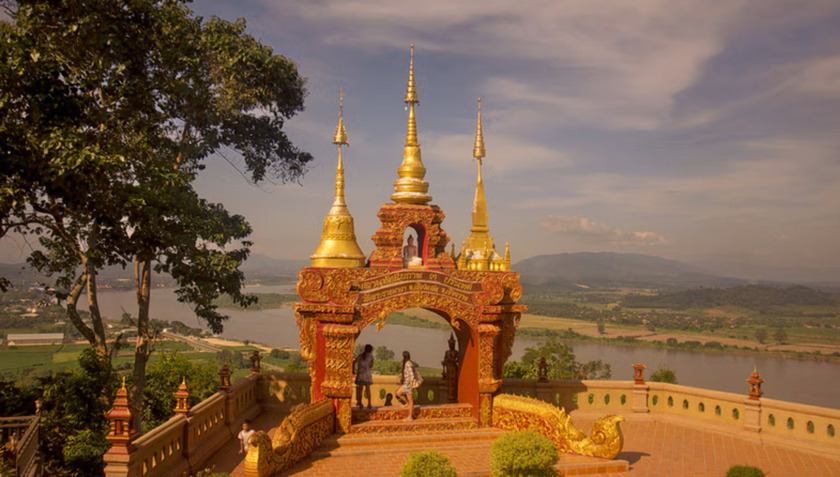
The once famous area
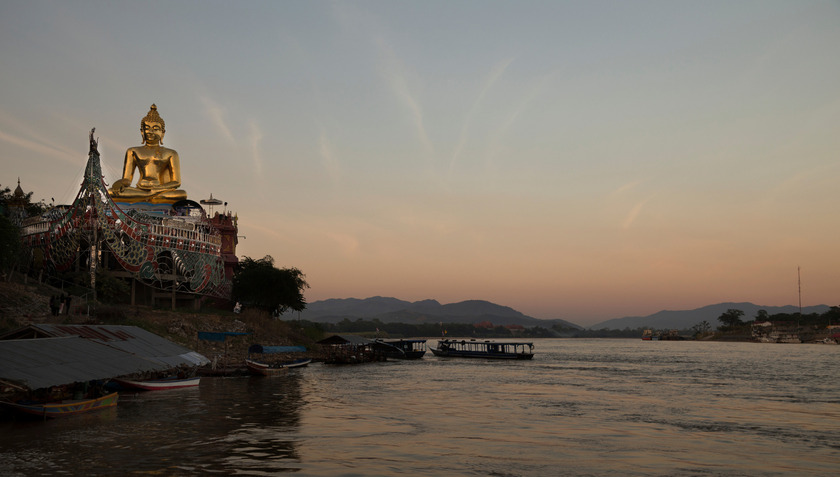
The Opium House is located just 2 km from the Golden Triangle. It displays the history of opium trade and consumption, with a highlight being a model of the drug trafficking route from southern China to Thailand, as well as the dangers of drugs and the lives of cannabis growers along the Mekong River. Open daily from 7:00 am to 7:00 pm. Entrance fee is 50 baht (VND 34,000).
Therd Thai village - one of the headquarters of drug lord Khun Sa
If you come to Chiang Rai without visiting Therd Thai village, it cannot be called a Golden Triangle tour. In the past, this place was very poor but the mountain roads were dangerous and very difficult to attack, so the boss Khun Sa occupied this place as a base. Of course, now everything is gone, the remaining lair is just a deserted camp with rusty corrugated iron roofs. But this village is the number 1 place if tourists really want to explore the secrets of the Golden Triangle.
PHUKET - THE ISLAND OF A MIX OF CULTURES
Located in the prosperous southern region of Thailand, Phuket Island has a rather interesting history. Thanks to its prime location, when Europeans first set foot on the island in the 16th century, most of them introduced Western culture to the island, which is most clearly shown through the blend of local architecture and cuisine. Although the largest island in Thailand, Phuket has a completely different culture from the rest of the country: a blend of Fujian, Chinese, Thai and Malaysian elements.
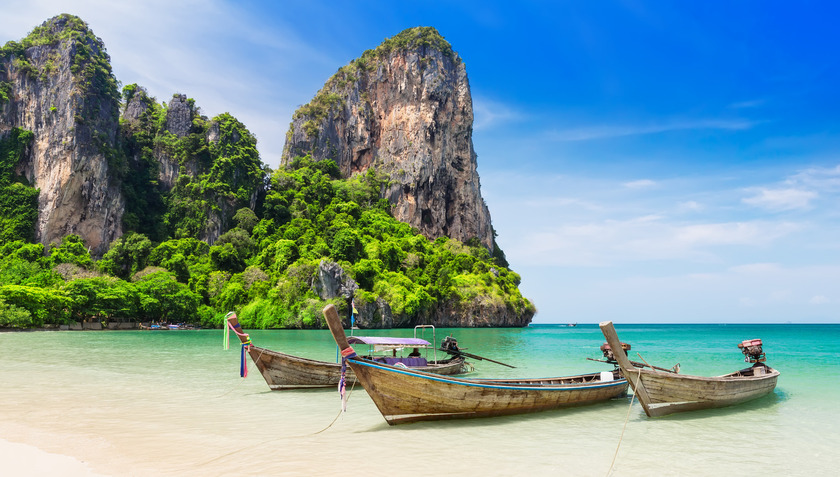
Europeans have been here since the 16th century, but the largest foreign population here belongs to China when they rushed to mine aluminum in the late 19th century.
In addition, Chinese culture has also influenced Phuket like many other areas in Thailand. The people here call this special culture “Baba” or “Peranakan”.
Phuket’s architecture is also unique, a testament to its past Portuguese rule. The Sino-Portuguese shophouses, with their distinctive colours, tiles and fusion of Western and Eastern styles, line the streets of the Old Town, reminiscent of shophouses in Penang and Singapore.
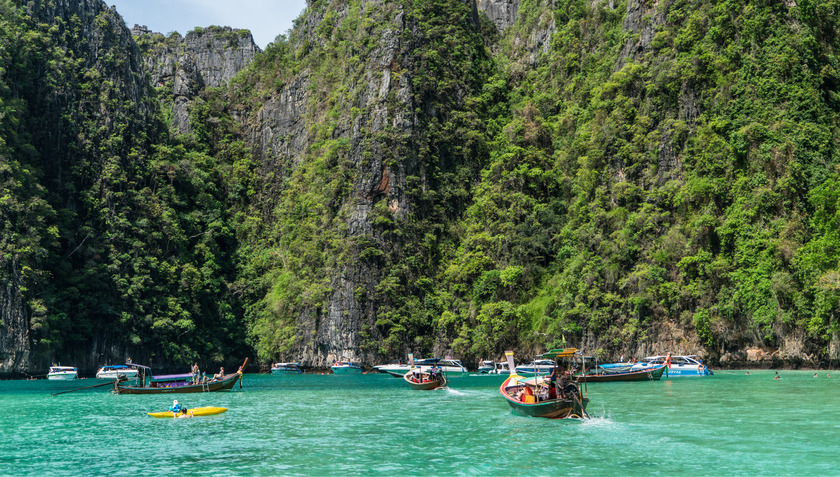
Thailand's prime resort destination, Phuket is renowned for its towering mountains and lush jungles, stunning beaches and turquoise waters.
It can be said that Phuket is quite influenced by Chinese culture, and there are even festivals held here to celebrate Chinese holidays. That is to say, Phuket Town is not short of ancient Chinese temples. Accordingly, the most notable places are the Taoist temple built in the 1890s, currently located on Phang-Nga Road.
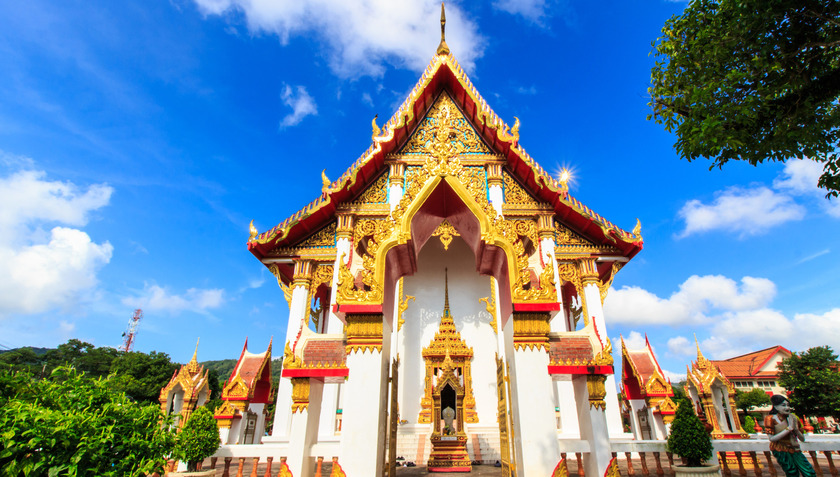
THAILAND FLOATING MARKET
Visiting Thailand's floating markets is considered a specialty in tours to the Land of Golden Pagodas. Each market will have its own unique characteristics, from the way of selling, the items on display to the culinary experience. In particular, the floating market is also a place to preserve the typical cultural features of the Thai people, where people live and earn a living in harmony with the river nature.
Damnoen Saduak Floating Market - A unique cultural feature in Thailand
Damnoen Saduak Floating Market is an ancient floating market located in Damnoen Saduak district, Ratchaburi province, 105km from the center of Bangkok. Unlike normal floating markets, Damnoen Saduak does not take place on the river but on the intricate canals of Ratchaburi province. This is a famous crowded floating market with a wide variety of goods.
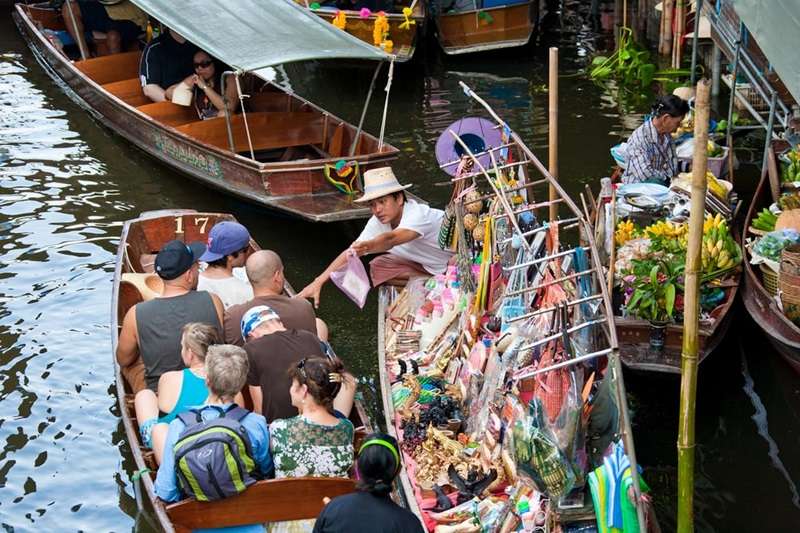
Thailand's floating market is one of the attractive destinations that tourists cannot miss when coming to the land of golden temples.
Damnoen Saduak floating market is located along the 10m wide canals that flow into the main river. The boats are always full of goods such as fruits, vegetables, spices... skillfully steered by the sellers on the canals imbued with the ancient cultural breath of Thailand, which is also a characteristic of Damnoen Saduak floating market.

With its long existence and presence in James Bond's chase more than 30 years ago, Damnoen Saduak floating market has become one of the famous ancient markets that tourists must visit when traveling in Thailand.
The floating market is held on a canal, so there are paths for tourists along both banks of the canal. However, if you want to enjoy the feeling of sitting on a boat and drifting on the flowing water, you can rent a boat to go around the market. The boat rental price will fluctuate around 2000 baht (about 1.4 million VND).
By rowing skillfully, they will take you to the boats full of goods of the sellers. You can buy everything you like right there. Or they will take you for a walk around the floating market, you will be immersed in the atmosphere that is both bustling but still retains the ancient features of Thai culture.
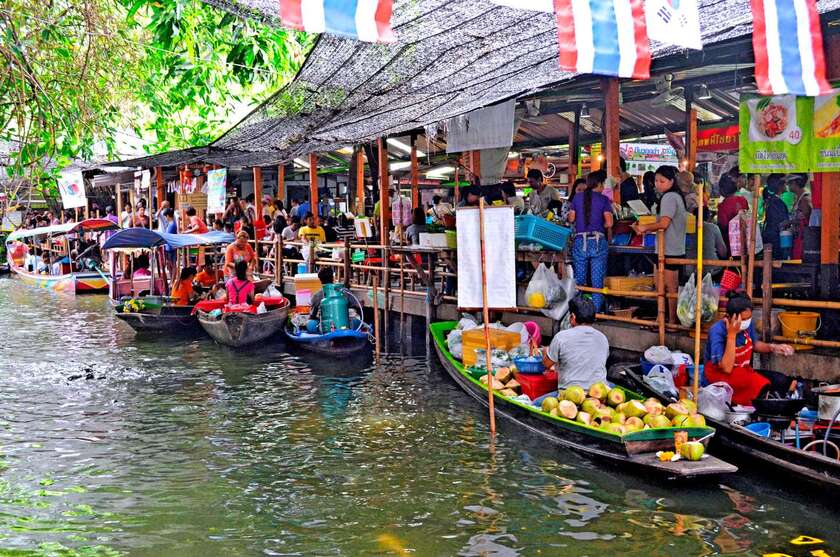
The market does not meet on one stretch of river but is located in all the small canals.
When visiting Damnoen Saduak floating market, you will be surprised by the brilliant beauty of the boats containing a variety of goods of the sellers. They sell juicy fruits to typical Thai dishes such as grilled meat, Thai tea, mango sticky rice,...
A rather impressive point is the image of the market vendors wearing hats woven from palm leaves, enthusiastically offering their goods. Believe that the colorful images combined with the bustling atmosphere will accidentally make your stomach growl with hunger, so you should go early and keep an empty stomach to be able to fully enjoy the flavor of the food.
KHAO YAI NATIONAL PARK - THE GREEN LUNG OF THAILAND
Thailand is famous for its special "green patches" in the land of golden temples, which are eco-tourism areas, and Khao Yai National Park is a must-see.
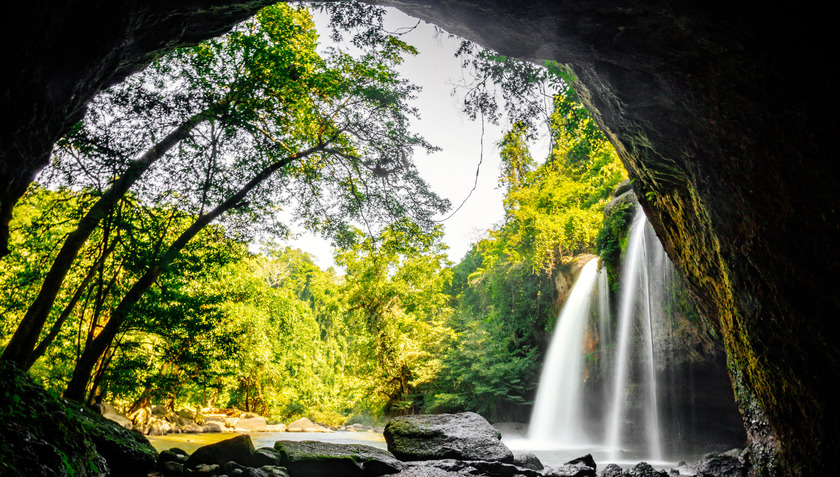
This place is likened to a miniature Europe in the heart of Thailand, a beautiful, peaceful land completely different from the bustling, prosperous urban areas.
Khao Yai National Park covers an area of 2,168 km2, making it the second largest national park in Thailand. Khao Yai National Park stretches across many provinces such as Nakhon Ratchasima, Saraburi, Prachinburi and Nakhon Nayok. The altitude ranges from 400m to 1000m above sea level. Khao Yai National Park is home to 300 species of plants, 320 species of birds, and 67 rare species of mammals.
Regarding birds, Khao Yai National Park currently has about 320 species, especially this place owns the largest hornbill population in Thailand. Coming here, you can see large hornbills, oriental hornbills in the central area, if you are lucky you will see the rare red-tailed robin. There are still many other rare birds here such as white-browed doves, wild birds, Austen's brown hornbills,...
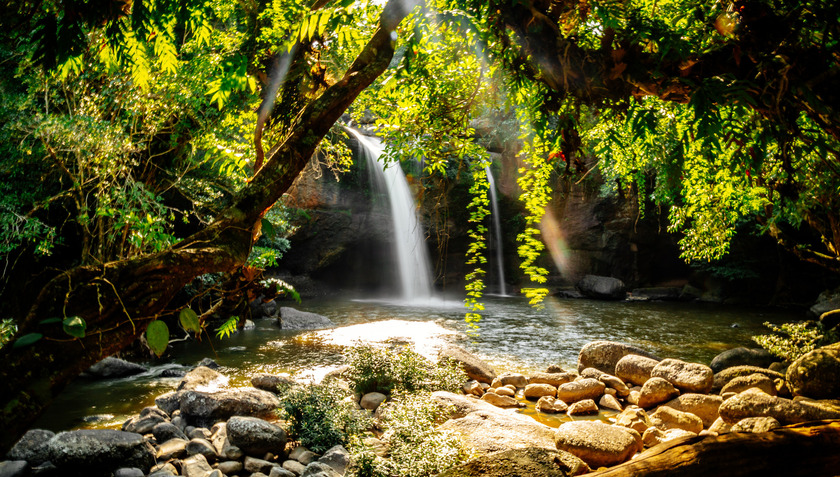
As soon as you set foot in Khao Yai, the scenery is in contrast to the crowded, noisy cities, it is a quiet and green land.
Khao Yai National Park is surrounded by a very large river basin, there are more than 12 trails through the forest with a length of 1.5 to 8 km and it usually takes about 1 to 6 hours to move. If you want to see beautiful waterfalls, visitors can move along Krong Kaew road, there are many waterfalls such as Heo Suwat 25m high, Pa Kuay waterfall, Heo Narok waterfall 150m high with 3 floors,...
KOH SAMUI, THE MOST PRIMITIVE ISLAND IN THAILAND
Koh Samui, Thailand's third largest island, is located in Surat Thani province, east of the Malay peninsula, south of Bangkok. Koh Samui is like a hidden gem in the ocean, attracting tourists with its captivating beauty.
Maenam Beach welcomes visitors with its long stretch of fine white sand and emerald green sea water, bringing a sense of peace and relaxation from the first moment of arrival. This is an ideal destination for those who wish to escape the hustle and bustle of everyday life to immerse themselves in pristine nature.
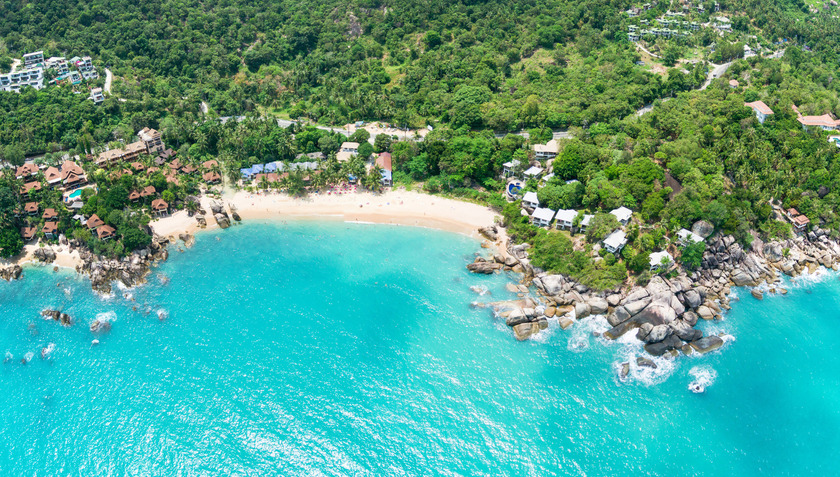
The wild beauty of the beach but makes many people fascinated
Visitors can freely stroll on the fine sand, watch small fishing boats drifting on the sea, or participate in exciting activities such as surfing, kayaking. Enjoy relaxing moments at cafes and restaurants along the beach.
Wat Phra Yai, located on the top of Pratumnak Hill, between the bustling Pattaya and Jomtien beaches, is one of Thailand's most famous spiritual destinations on the island of Koh Samui. The temple was built in the 1940s and was recognized as a World Cultural Heritage by UNESCO in 1991.

Clear blue beaches and fine golden sand are what this island has.
Wat Khunaram, a famous temple located on Koh Samui Island, attracts tourists by the presence of the mummy of Luong Pordaeng – a monk who passed away peacefully in meditation. The mummy of this monk is kept here as a testament to enlightenment and spiritual longevity.
AYUTTHAYA - A DESTINATION FOR HISTORY LOVERS
The historic city of Ayutthaya served as the capital of Siam from the 14th to the 18th centuries before being conquered by the Burmese. The ruins of that city have since been declared a UNESCO World Heritage Site, making it the perfect place to explore.

Built in the 14th century, Ayutthaya became one of the largest cities in the world at that time and with its beauty and prosperity
Ayutthaya is located in Phra Nakhon Si Ayutthaya district (Ayutthaya province) with a total area of 289 hectares. Ayutthaya was chosen by King Uthong as the capital of the Ayutthaya kingdom in the 14th century. During its 400-year history, Ayutthaya was one of the largest trading centers in the world, thriving thanks to its prime location on the trade route between China and India.
The city was named after Ayodhya - the homeland of the hero Rama in the Hindu epic. In 1767, Ayutthaya was attacked and burned by the Burmese army. After the Ayutthaya kingdom collapsed, King Rama I (1737 - 1809) founded the Chakri dynasty and moved the capital to Bangkok.

In the 18th century, Ayutthaya was almost completely destroyed during the Siamese-Burmese war and today we can only see a few remaining ruins, but that still cannot hide the beauty of its golden age.
Ayutthaya is strategically located on an island surrounded by three rivers, so it has an advanced hydraulic system to regulate water. Once an important diplomatic and commercial center in Asia, Ayutthaya is now a destination that harmoniously combines the modern and the ancient. The architecture is characterized by soaring pagodas and magnificent Buddhist monasteries. Ayutthaya's architecture is laid out in a systematic and tightly planned network of roads, canals and moats around the central power center.
The feeling when staying in Ayutthaya is quite peaceful, the statues are surrounded by rows of banyan trees creating a very pure and quiet scene.





